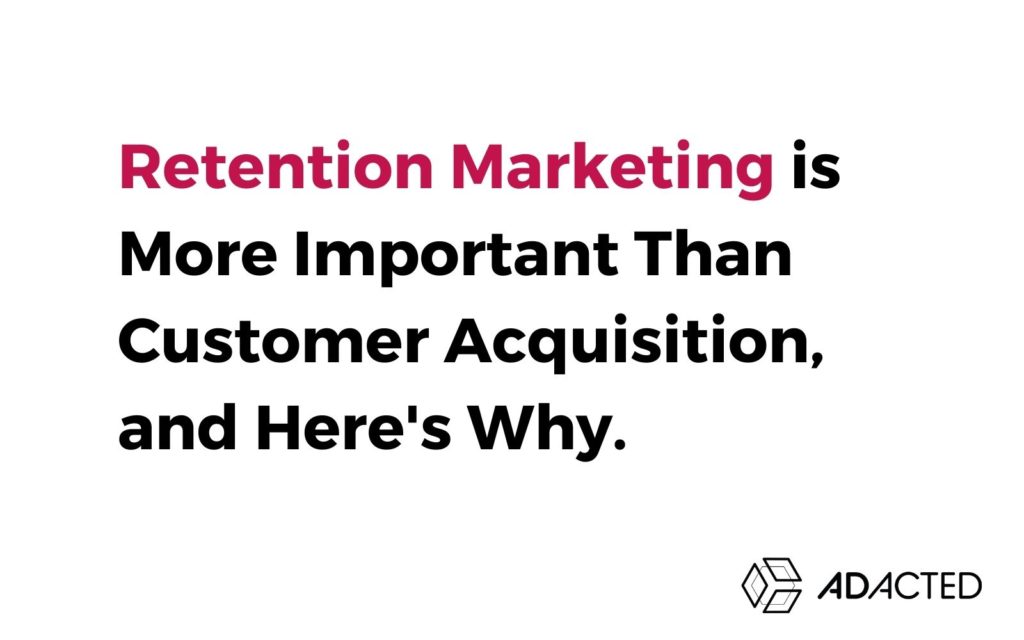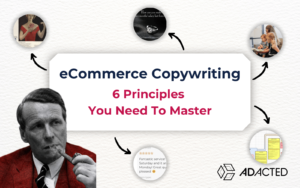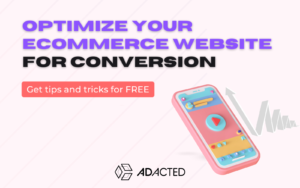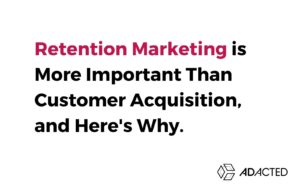Every company has a limited budget for marketing and advertising. Marketing experts will often tell you to focus your efforts on acquiring new customers. While this might be a good idea when looking at one-time sales, customer retention marketing can actually yield greater revenue over time. Here’s why:
Customer Retention Is More Profitable
- Studies by Bain & Company, along with Earl Sasser of the Harvard Business School, have shown that even a 5 percent increase in customer retention can lead to an increase in profits of between 25 and 95 percent.
- The success rate of selling to a customer you already have is 60-70%, while the success rate of selling to a new customer is 5-20%.
- Repeat purchasers spend more and generate larger transactions. In their study, the longer their relationship with an online retailer, the more customers spent in a given period.
Customer loyalty on the Internet is a key driver of long-term profitability. Loyal online customers, just like offline ones, spend more, refer more people, and are more willing to expand their purchasing into new categories.
Existing customers repeat purchases
Expanding on this concept, Gartner found that the cost to replace a customer amounts to between 150 and 200 percent of that customer’s annual revenues. This means that you could spend up to twice as much money trying to replace a customer than the value of their business!
What is the difference between customer retention, retention marketing, and customer acquisition?
- Customer retention is the tactic of developing long-term customer retention strategies to maximize sales and minimize marketing spending.
- Retention marketing is a strategy that markets to existing customers. It focuses on bringing back customers who have already done business with a brand.
- Customer acquisition, conversely, is a tactic that markets to new customers. It focuses on attracting new customers by using traditional marketing tools, such as advertising and public relations.
Customer Acquisition vs Customer Retention
Customer Acquisition is more expensive than Customer Retention because initial customer acquisition costs can be five times more than retaining an existing customer as brought out by the Bain & Company study.
In other words, it’s far more expensive to gain a new customer than to retain existing customers. This makes intuitive sense because acquiring a new customer requires money for advertising or sales commissions, as well as any necessary consulting costs before the new customer is ready to buy.
In contrast, a company can retain its existing customers through a variety of methods — from rewards programs and newsletters to social media campaigns and public relations efforts.
These initiatives might not make a huge dent in increasing revenues, but they can certainly avoid draining revenue.
It’s no coincidence retention has become one of the biggest trends in marketing strategies.
If retention marketing is the new trend in customer retention strategies, why are some businesses still struggling to keep loyal customers?
Most retention marketers will admit that retention marketing takes time. Customers don’t always respond at first and it can take a while to understand how your customer retention efforts are working. But this is part of retention marketing, and retention marketers understand this process.
For many businesses, customer acquisition is still the priority. Companies are investing in new customers before they retain their existing ones.
This may be one of the reasons that customer retention marketing hasn’t taken off yet — brands are still trying to grow by buying customers in competitive markets when it would be cheaper in the long run to retain their existing customers.
4 Retention Marketing Tips to Help You Get Started
1. Recognize that it’s hard work that will take time
Retention marketing is all about building relationships with your customers and meeting their needs over time, so expect to put in the legwork! But remember: It can be well worth the effort. Having a good business model will bring customers to you.
2. Expect a lot of testing and tweaking
Remember: Businesses maintain customer loyalty through different programs and initiatives, so it’s important to keep testing your strategies. A successful business is constantly evolving and responding to its surroundings.
3. Be proactive
Put yourself in the mind of your customers and think about where they are likely to spend time online. Then, go there! Set up accounts on social media sites like Facebook or Twitter and talk to them. When you do direct marketing through these platforms, it’s easy to stay in touch with them and build customer relationships. Keeping customers happy and feeling involved will lead to valuable sales.
4. Focus on the customer satisfaction
When your goal is to increase the number of loyal customers, you must pay attention to their overall experience with your business. Make sure the customer sees value in every interaction they have with you — whether it’s through sales or service efforts, social media marketing, newsletters, e-mails, or another communication medium.
Ultimately, by providing them a great customer experience every time they interact with your business you increase your customer lifetime value because you increase the likelihood of repeat purchases.
So as you retain customers through social media, newsletters, and other communication mediums, don’t forget that customer acquisition is still important.
Remember! A happy customer base is vital to keep new customers coming. They are your best brand advocates.
Finding a Balance Between Customer Acquisition and Retention Marketing
How to exactly fine-tune the marketing spend and whether to focus on acquiring customers or retaining old ones depends on your overall marketing costs and budgets. Acquisition efforts include all acquisition expenses, such as advertising, for example for lead generation. Retention marketing involves activities that cater to existing customers, not new ones. Dealing more with loyalty programs, follow-up emails, and content marketing to already engaged customers.
Retention Marketing Strategies
One very important practice for retention is advertising in the right channels. Knowing how to get your customer retention efforts in front of people is just as important as having the right customer retention strategies in place.
Retention marketing examples
Not all of them will work, so be sure to do some research before selecting a retention marketing strategy you want to implement for your business. Some ways to keep your customer retention marketing effective are by sending customer newsletters, customer retention surveys, customer relationships management, customer feedback programs, and customer loyalty programs.
Example retention marketing campaigns
- Email campaigns
- Customer gifts
- Loyalty program discounts
- Paid subscription content
- Customer surveys
The First Step of Successful Marketing is to Know Thy Customer
Customer data allows marketers to target the right people at the right time with the correct offer, which results in increased revenue and reduced costs. Data can be whatever you want it to be – demographic information, online activity, email address history, purchase history, etc.
Understanding your customer is more than just knowing who they are; it’s about knowing how they act and what their needs are.
Are there special events or seasons that trigger purchases?
Do some customers need extra attention because of past buying behavior (high-volume purchasers, high-value purchasers)?
Use Your Existing Customer Base
Loyal customers and past customers tend to repeat purchases from the same business. What is their purchase frequency and are there ways through marketing tactics to encourage customers to become repeat customers sooner?
1. Understand your customer’s needs and what drives customer behavior.
2. Target the right customers with the right message at the right time.
3. Determine customer behavior through customer history and customer data to improve retention rates over time.
4. Customer understanding leads to satisfaction and loyalty, customer retention, customer value, customer lifetime value.
5. Knowing your customer will help you determine what marketing tactics to use and how much to spend.
Customer data will help you guide marketing efforts to drive repeat purchases from current customers.
Businesses are Taking Advantage of Every Move The Customer Makes
For some businesses, customer acquisition marketing is more financially sustainable than customer retention marketing. Depending on the market and brand awareness goals, it might make sense to focus on customer acquisition at first.
This way companies can keep costs low while acquiring new customers who will eventually turn into repeat customers for increasing customer retention rates later down the road.
What do you want from customer acquisition?
Focusing on customer acquisition makes sense when a business, such as a new eCommerce business, wants to increase customer awareness and brand knowledge to ultimately drive customer retention later on.
However, customer retention marketing will require more resources overall since data about customers needs to be gathered and analyzed over longer periods, which can include multiple touchpoints throughout the customer journey.
Customer retention marketing is a long-term strategy that requires understanding customers over time.
If your goal is to increase immediate returns through customer awareness and acquisitions now, with the potential for high volume repeat purchases down the road, then customer acquisition may be right for you. Keep in mind that it’s also important to strike a balance between acquiring new customers and retaining existing ones.
What do you want from customer retention?
On the other hand, it’s often a better idea to focus on retention when you have a strong understanding of your existing customers and their needs.
Data will play a huge role in helping you retain customers because it allows marketers to know what type of content each customer prefers when they prefer to engage with brands and any specific problems or issues that need to be addressed.
Such behavior-based data is essential in increasing revenue from repeat purchases from existing customers over time.
For example, frequent flyers with airlines are likely going to want flight deals through email promotions compared to someone who only flies once every two years. Understanding your customers’ preferences and how they behave with your brand is the foundation for successful marketing strategies.
How to Effectively Reduce Marketing Costs
While cost-effective measures will vary by business, marketers need to understand the cost of acquiring and retaining customers.
For example, when deciding between customer acquisition or retention efforts, cost per acquisition (CPA) is generally lower than cost per retention (CPR).
Since it can be more cost-effective to acquire new customers compared to keeping current ones through marketing tactics, many businesses tend to focus on CPA over CPR so they don’t lose out on potential revenue from existing customers.
On the other hand, if there are high costs associated with customer attrition (customer churn), that means a business needs to work harder at increasing retention rates because every lost customer decreases profits and affects the company’s bottom line.
Where retention shines and comes out on top, over acquisition, is sustainability, scalability, and reduced marketing costs.
This means that retention is cost-effective when looking at your business in the long term since finding new customers is often an expensive process even though they may initially cost less than finding existing ones.
Overall, what’s important here is to make cost-effective decisions and to be aware of all the costs associated with acquiring and retaining customers because it’ll help you get a better idea of your bottom line.
Final Thoughts
Businesses should focus on retention tactics to keep their customers rather than spending money on acquiring new ones. This is because retention is more sustainable, scalable, and cost-effective in the long run.
Customer retention is more profitable than customer acquisition, and it is much less expensive to retain a customer than to find a new one. In addition, existing customers are more likely to refer friends and family members, and they are also more likely to buy additional products and services. Finally, it costs significantly more money to replace a lost customer than to keep an existing one.
Web companies such as Google and LinkedIn have been using the incredible power of user retention to grow their brands. For a company like Google or LinkedIn, user acquisition is an expensive process that requires a very heavy marketing budget. It’s not often a new startup can afford to compete with big brand names when it comes to gaining customers – but what if they didn’t need to?
The lessons learned from Google and LinkedIn’s strategies are clear – focusing on customer retention is an incredibly powerful source for any business, especially young startups trying to get off the ground!
Ready to take your retention marketing and acquisition to the next level?







